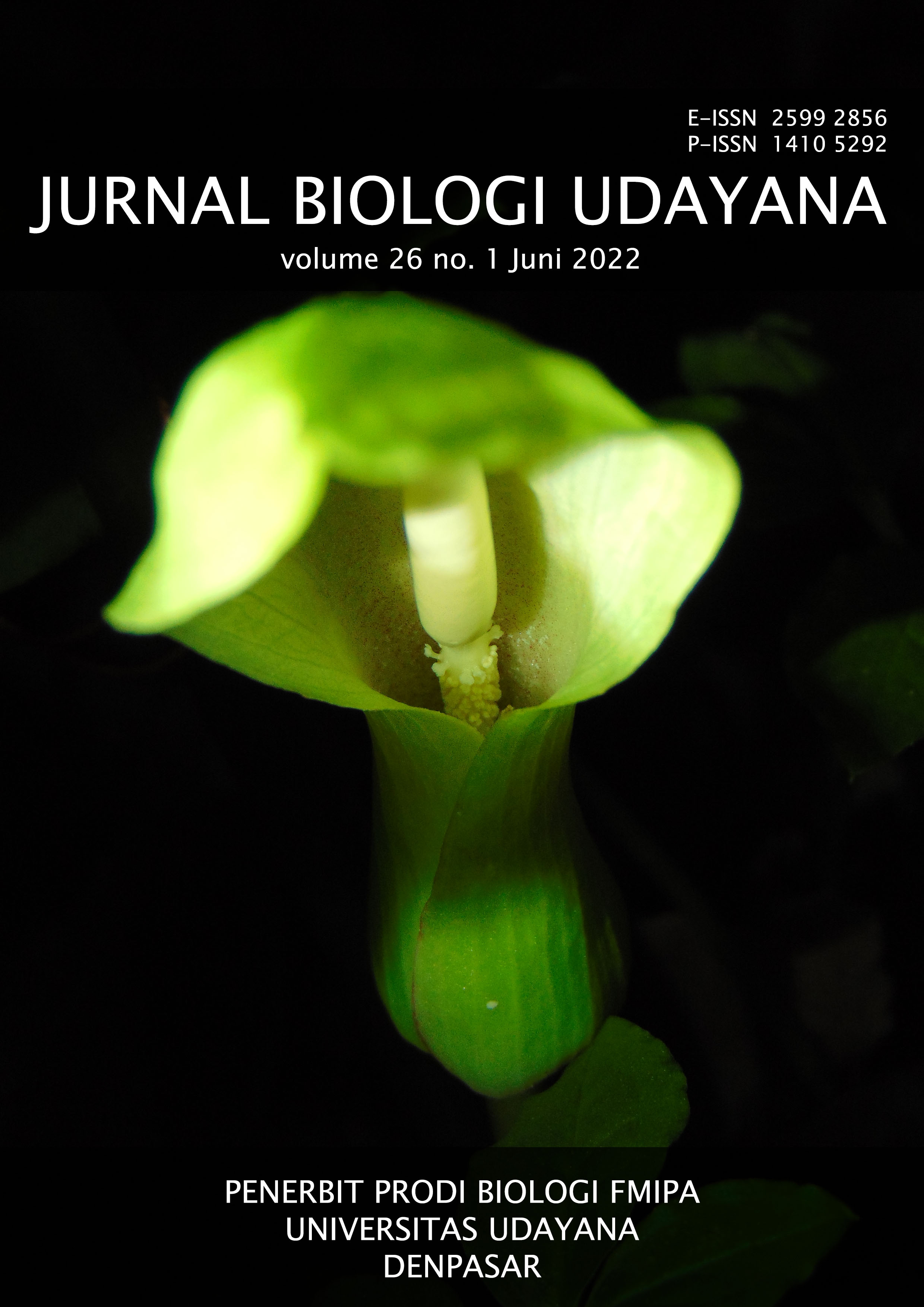Laju dekomposisi bangkai mencit (Mus musculus) yang dikubur selama empat minggu pada media tanah humus, kapur, dan pasir pantai
Abstract
Dekomposisi bangkai terjadi segera setelah organisme mati mulai dari dekomposisi tingkat jaringan hingga tingkat molekuler. Laju dekomposisi bangkai hewan yang dikubur dipengaruhi oleh tiga faktor yaitu faktor fisik, kimia, dan biologi dari media yang digunakan mengubur bangkai. Faktor fisik berupa struktur, porositas, dan kelembaban dari media. Faktor kimia berupa pH, konsentrasi natrium, nutrien, dan oksigen yang terkandung pada media penguburan. Faktor biologi berupa jumlah dan komposisi dari koloni bakteri, invertebrata, dan flora yang hidup pada media. Tujuan dari penelitian ini adalah untuk mengetahui apakah terjadi perbedaan kecepatan dekomposisi bangkai pada media penguburan yang berbeda. Penelitian ini dilakukan dengan menggunakan bangkai mencit sebanyak 36 ekor yang dikuburkan pada tiga media berbeda yaitu tanah humus, pasir pantai, dan tanah kapur di dalam toples plastik. Masing-masing sebanyak 12 toples diisi dengan media yang sama sebagai ulangan. Bangkai mencit diamati selama 28 hari dimana tiap tujuh hari dilakukan penimbangan terhadap berat bangkai mencit dengan timbangan digital dan kondisi fisik dari bangkai mencit dicatat dan diskoring. Laju dekomposisi bangkai mencit ditunjukkan dari perbedaan rata-rata penurunan berat bangkai mencit (%) tiap minggu pada masing-masing media. Metode analisis data dilakukan dengan uji ANOVA. Hasil dari penelitian didapatkan adanya perbedaan penurunan berat dan nilai skor kondisi fisik bangkai mencit pada tiap media penguburan. Kesimpulan penelitian ini adalah waktu dan perbedaan media penguburan berpengaruh pada penurunan berat dan nilai skoring kondisi fisik bangkai mencit.
Downloads
References
Bui A. 2009. Beach Burial of Cetaceans: Implication for Conservation, and Public Health and Safety. Earth & Oceanic Sciences Research Institute and School of Applied Sciences. Auckland University of Technology. (Thesis).
Byrd JH, Tomberlin JK. 2019. Forensic Entomology: The Utility of Arthropods in Legal Investigation Third Edition. CRC Press: Florida.
Carter DO, Tomberlin JK, Benbow ME, Metcalf JL. 2017. Forensic Microbiology. John Wiley & Sons: West Sussex.
European Commission. 2010. The Factory of Life Why Soil Biodiversity is So Important. European Union: Belgium.
Fiantis D. 2018. Buku Ajar Morfologi dan Klasifikasi Tanah. Lembaga Pengembangan Teknologi Informasi dan Komunikasi Universitas Andalas: Padang.
Harjadi B, Nugroho AW, Abdiyani S, Miardini A, Octavia D. 2014. Pedoman Teknis Pengelolaan Lahan Bermasalah Pantai Berpasir dengan Cemara. Balai Penelitian Teknologi Kehutanan Pengelolaan Daerah Aliran Sungai: Surakarta.
Hau TC, Hamzah NH, Lian HH, Hamzah SPAA. 2014. Decomposition Process and Post Mortem Changes: Review. Sains Malaysiana 43(12): 1873-1882.
Intara YI, Sapei A, Erizal, Sembiring N, Djoefrie MHB. 2011. Pengaruh Pemberian Bahan Organik pada Tanah Liat dan Lempung Berliat Terhadap Kemampuan Mengikat Air. Jurnal Ilmu Pertanian Indonesia 16(2): 130-135.
Kasifah. 2017. Materi Kuliah Dasar-Dasar Ilmu Tanah. Fakultas Pertanian Universitas Muhammadiyah Makassar: Makassar.
Lancu L, Junkins EN, Petrareanu GN, Purcarea C. 2018. Characterizing Forensically Important Insect and Microbial Community Colonization Patterns in Buried Remains. Scientific Reports 8(15513): 1-16.
Lauber CL, Metcalf JL, Keepers K, Ackermann G, Carter DO, Knight R. 2014. Vertebrate Decomposition Is Accelerated by Soil Microbes. Applied and Environmental Microbiology 80(16): 4920-4929.
Nivethadevi P, Swaminathan C, Kannan P. 2021. Soil Organic Matter Decomposition-Roles, Factors, and Mechanisms. In: Sukul Singh Porte (eds) Latest Trends in Soil Science. Integrated Publications: Delhi, 61-91.
River DB, Dahlem GA. 2014. The Science of Forensic Entomology. John Wiley & Sons: West Sussex.
Rozeboom D, Ross D, Guthrie T. 2015. Caracass Composting – A Guide to Mortality Management on Michigan Cattle Farms. Michigan State University Extension Bulletin E3197.
Soon LP, See KL, Ahmad NW, Zulkapli A, Abdullah NK, Mahmood MS, Hasmi AH. 2017. The Effect of Cement and Wrapping on The Decomposition Rate of The Rabbit Carcasses. Journal of Forensic Science and Research 1: 46-62.
Stroud G. 2017. Comparison of the Decomposition of Buried Mus musculus (House Mouse) between Two Soil Types with Contrasting pH and its Potential to Assist Forensic Taphonomy. Faculty of Science and Technology. Bournemouth University. (Dissertation).
Sukandarrumidi HZ, Kotta, Wintolo D. 2018. Energi Terbarukan: Konsep Dasar Menuju Kemandirian Energi. UGM Press: Yogyakarta.
Surabian D. 2012. Preservation of Buried Human Remains in Soil. Natural Resources Conservation Service: Connecticut.
Susilawati, Doyan A, Taufik M, Wahyudi, Gunawan ER, Kosim, Fithriyani A, Khair H. 2018. Identifikasi Kandungan Fe Pada Pasir Besi Alam Di Kota Mataram. Jurnal Pendidikan Fisika dan Teknologi 4(1): 105-110.
Tumer AR, Karacaoglu E, Namli A, Keten A, Farasat S, Akcan R, Sert O, Odabasi AB. 2013. Effects of Different Types of Soil on Decomposition: An Experimental Study. Legal Medicine 15(3): 149-156.
Verbon EH, Trapet PL, Stringlis IA, Kruijs S, Bakker PAHM, Pieterse CMJ. 2017. Iron and Immunity. Annual Review of Phytopathology 55: 355-375.
Wescott DJ. 2018. Recent Advances in Forensic Anthropology: Decomposition Research. Forensic Sciences Research. 3(4): 327-342.
Wicaksono T, Sagiman S, Umran I. 2015. Kajian Aktivitas Mikroorganisme Tanah Pada Beberapa Cara Penggunaan Lahan Di Desa Pal IX Kecamatan Sungai Kakap Kabupaten Kubu Raya. Fakultas Pertanian. Universitas Tanjungpura. (Artikel).
Yan N, Marschner P, Cao W, Zuo C, Qin W. 2015. Influence of Salinity and Water Content on Soil Microorganisms. International Soil and Water Conservation Research 3: 316-323.
Yuliani, Rahayu YS. 2016. Pemberian Seresah Daun Jati dalam Meningkatkan Kadar Hara dan Sifat Fisika Tanah pada Tanah Kapur. Prosiding Seminar Nasional Biologi 42: 213-217.





